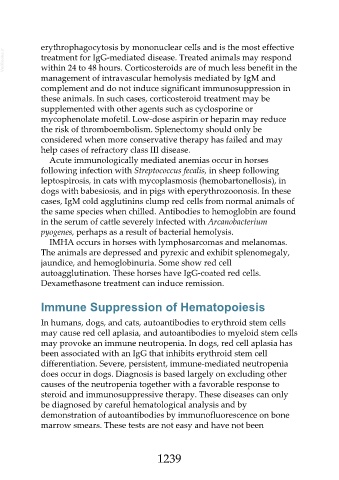Page 1239 - Veterinary Immunology, 10th Edition
P. 1239
erythrophagocytosis by mononuclear cells and is the most effective
VetBooks.ir treatment for IgG-mediated disease. Treated animals may respond
within 24 to 48 hours. Corticosteroids are of much less benefit in the
management of intravascular hemolysis mediated by IgM and
complement and do not induce significant immunosuppression in
these animals. In such cases, corticosteroid treatment may be
supplemented with other agents such as cyclosporine or
mycophenolate mofetil. Low-dose aspirin or heparin may reduce
the risk of thromboembolism. Splenectomy should only be
considered when more conservative therapy has failed and may
help cases of refractory class III disease.
Acute immunologically mediated anemias occur in horses
following infection with Streptococcus fecalis, in sheep following
leptospirosis, in cats with mycoplasmosis (hemobartonellosis), in
dogs with babesiosis, and in pigs with eperythrozoonosis. In these
cases, IgM cold agglutinins clump red cells from normal animals of
the same species when chilled. Antibodies to hemoglobin are found
in the serum of cattle severely infected with Arcanobacterium
pyogenes, perhaps as a result of bacterial hemolysis.
IMHA occurs in horses with lymphosarcomas and melanomas.
The animals are depressed and pyrexic and exhibit splenomegaly,
jaundice, and hemoglobinuria. Some show red cell
autoagglutination. These horses have IgG-coated red cells.
Dexamethasone treatment can induce remission.
Immune Suppression of Hematopoiesis
In humans, dogs, and cats, autoantibodies to erythroid stem cells
may cause red cell aplasia, and autoantibodies to myeloid stem cells
may provoke an immune neutropenia. In dogs, red cell aplasia has
been associated with an IgG that inhibits erythroid stem cell
differentiation. Severe, persistent, immune-mediated neutropenia
does occur in dogs. Diagnosis is based largely on excluding other
causes of the neutropenia together with a favorable response to
steroid and immunosuppressive therapy. These diseases can only
be diagnosed by careful hematological analysis and by
demonstration of autoantibodies by immunofluorescence on bone
marrow smears. These tests are not easy and have not been
1239

